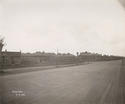 Mosspark and the lands of East and Mid-Henderston were incorporated into Glasgow in 1909. They covered seventy-two hectares of farmland and their acquisition was prompted by the need to develop peripheral communities to help ease the city's notoriously high levels of congestion. The background of the First World War was also crucially important for determining Mosspark's pioneering place in Glasgow Corporation's housing programme. In 1919 plans for reconstruction had been put in place by central government and ground breaking legislation made it compulsory for local authorities to implement planned housing schemes, underpinned by Treasury subsidies. As a result, Mosspark became the most ambitious of the Corporation's immediate post-war developments.
Mosspark and the lands of East and Mid-Henderston were incorporated into Glasgow in 1909. They covered seventy-two hectares of farmland and their acquisition was prompted by the need to develop peripheral communities to help ease the city's notoriously high levels of congestion. The background of the First World War was also crucially important for determining Mosspark's pioneering place in Glasgow Corporation's housing programme. In 1919 plans for reconstruction had been put in place by central government and ground breaking legislation made it compulsory for local authorities to implement planned housing schemes, underpinned by Treasury subsidies. As a result, Mosspark became the most ambitious of the Corporation's immediate post-war developments.
 Entirely residential, the scheme's green and semi-rural setting was intended to provide a healthier alternative to the city's traditional tenement landscape, which had become too much identified with urban corrosion. The Corporation's Housing Department designed Mosspark according to garden-suburb principles, based on examples set by the English architect, Raymond Unwin (1863-1940), notably the emergency wartime munitions centres of Gretna and Eastriggs in Dumfriesshire. Although flats featured in Mosspark's plans, two-thirds of the housing stock was built in the form of cottages, semi-detached and terraced, and surrounded by gardens.
Entirely residential, the scheme's green and semi-rural setting was intended to provide a healthier alternative to the city's traditional tenement landscape, which had become too much identified with urban corrosion. The Corporation's Housing Department designed Mosspark according to garden-suburb principles, based on examples set by the English architect, Raymond Unwin (1863-1940), notably the emergency wartime munitions centres of Gretna and Eastriggs in Dumfriesshire. Although flats featured in Mosspark's plans, two-thirds of the housing stock was built in the form of cottages, semi-detached and terraced, and surrounded by gardens.
 The dwellings were built to high standards with spacious rooms and modern conveniences including the clean new energy source of electricity. Over time the area became one of the most desirable for Corporation tenants with higher-income families predominating. The district's exclusive character had arisen because it was generally not cost-effective for the Corporation to build such prestigious, low-density developments, especially in the depressed economic climate of the inter-war years. Mosspark was consequently a showpiece of modern planning in Glasgow, but it could not serve as a realistic blueprint for the Corporation's long-term housing strategy.
The dwellings were built to high standards with spacious rooms and modern conveniences including the clean new energy source of electricity. Over time the area became one of the most desirable for Corporation tenants with higher-income families predominating. The district's exclusive character had arisen because it was generally not cost-effective for the Corporation to build such prestigious, low-density developments, especially in the depressed economic climate of the inter-war years. Mosspark was consequently a showpiece of modern planning in Glasgow, but it could not serve as a realistic blueprint for the Corporation's long-term housing strategy.